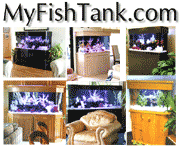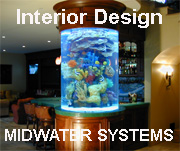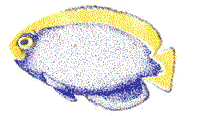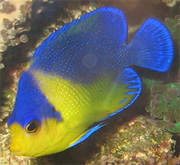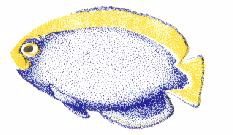|
Clownfish Larvae
By Stanley Brown
The Breeders Registry
The eggs typically hatch within two hours of the onset of darkness (lights
out). The aquarist must be prepared for this event and should have
a separate rearing tank ready to receive the larvae. A 10 or 20 gallon
tank is adequate for this purpose. I have successfully reared 30
– 50 larvae through metamorphosis to 30 days in a 2-½ gallon “fishbowl”
before needing to transfer the juveniles to a larger vessel. The
sides should be “blacked out”, either by painting the outside of the glass
black or covering with black plastic or paper. There is some disagreement
as to the bottom of the tank; some recommend a white bottom so that cleaning
is easier. Others recommend a black background so that the food organisms
are easier for the larvae to see. I have no opinion on this and opt
for black simply to avoid needing two colors of paint.
Water from the parents’ tank is preferable and should be used initially.
If using a small aquarium, I would recommend only filling it with 5 gallons
initially (I’ll explain why shortly). If you need a submersible heater
to the maintain temperature the same as the adult tank, use a heater guard
and cover the pilot light with vinyl (electrical) tape. The larvae
are phototaxic meaning they are attracted to light. They are not
strong swimmers during the first week and there have been numerous reports
of finding dead larvae in the vicinity of the heater (apparently attracted
by the light and killed by the hot water surrounding the heater).
An air source with a length of rigid tubing to provide circulation and
improve gas exchange at the surface (do not use an airstone until later).
A light source sufficient to illuminate the area and a timer to control
the photoperiod. Some people leave the lights on 24 hours the first
few days, however, I have used a 14 hour light / 10 hour dark cycle with
good success.
You will need to have your rotifer and greenwater cultures established
otherwise your efforts will be disappointing if not completely in vain.
The purpose of this article is not intended to instruct or advise on greenwater
(single celled alga cultures), rotifer, or brine shrimp culture.
Wilkerson 1999 and Moe 1988 cover this topic quite well.
Now you await the moment of hatching with a small bowl/dish and a flashlight.
Newly hatched larvae are quite small ( 1 – 2 mm), relatively transparent
except for a very small yolk sac and reflective eyes. Once you detect
that hatching has begun, turn off the tank filtration. (unless you want
to “share” the hatch with your filter!) I use a “mini-mag” flashlight that
I manage to tape to the side of the aquarium in a corner so that it shines
into the tank just below the waterline. There are designs for larval traps
available (Wilkerson 1999, Brown 1998 ), but I think everyone should experience
the joy of standing over a tank in the dark for several hours while trying
patiently to capture every last larvae!
The larvae will swim towards the light and can be collected by dipping
the bowl into the water so that they are pulled into the bowl as it fills.
The contents of the bowl is then transferred gently to the rearing tank.
Once you have accomplished this task, turn off the flashlight, turn the
filtration system back on in the adult tank and get some sleep. The
yolk sac provides an initial reserve and they will not need to be fed just
yet. Although some aquarist stock/inoculate the rearing tank with
rotifers and greenwater prior to transferring larvae you can wait until
the next day to do so.
The larvae do best on an initial diet of rotifers and the general rule
of thumb is that the larvae should not need to swim more than 1 body length
in order to feed. What this means is you need lots of rotifers.
This is also why I recommended starting with a smaller volume of water
in your rearing tank (as opposed to filling it up). The rotifers
must be fed so as to be nutritional for the larvae. Greenwater is
commonly added to the rearing tank so that the rotifers will have a food
source. Additionally, the alga cells can make use of some of the
nitrogenous compounds from the larvae waste (feces).
Water changes are a necessity. Unless one is changing 100% of
the water (neither practical, nor a good idea), a water change represents
a dilution of the pollutant (whatever it is you’re trying to reduce).
Dilution will never eliminate the pollutant. You can remove a portion
of the water and replace it with “clean” water, or add more water and increase
the overall volume. Either way the effect is the same; the pollutant
levels have been reduced. By starting with 5 gallons in your rearing
tank, you can add 1 gallon daily and essentially have the same results
as a water change. The advantage (in my opinion) is that this method
eliminates the possibility of removing larvae while siphoning out water
(literally throwing out the baby with the bathwater) and you are slowly
increasing the volume (living space) to allow for growth and reduce overcrowding.
You will need to make allowances when feeding for the increased volume.
By the time the tank is full. The larvae should be both large enough and
strong enough swimmers to avoid the siphon tube.
Back to feeding… rotifers should be fed for the first 10 – 14 days.
Metamorphosis occurs anywhere from 6 – 10 days (typically).
Metamorphosis is when the larvae change to juveniles. They undergo
some distinct physical changes and look more like clownfish. This
is a crucial time and good nutrition and water quality will help to decrease
the mortality rate. Newly hatched brine shrimp should be introduced
at about day 7 and ideally not be offered for more than 10 days.
Rotifers can be discontinued when you observe that the larvae/juveniles
are all able to feed on the brine shrimp. After 5 days of feeding
brine shrimp begin introducing prepared foods (flake, grated frozen shrimp,
etc.) and discontinue feeding brine shrimp as soon as the juveniles accept
the prepared foods.
Once metamorphosis has taken place replace the rigid airline with a
foam filter. Depending on the number of anemonefish you have successfully
reared, you may need to move to a larger tank to reduce losses due to aggression
and to insure that all of the fish are getting enough to eat for good growth.
Marketable size is generally > 1”. 4 – 6 months is a reasonable expectation.
Marketing now becomes your challenge as you one-day wonder “what
am I going to do with all these fish!?!”
i- Fautine, Daphne G. & Allen, Gerald, R., 1994,
Anemonefishes and their Host Sea Anemones, Tetra Press, Germany.
ii- Personal communication, 2000, Joe Lichtenbert, Reef
Propagation’s, USA.
iii- Ibid. i
iv- Moe, Martin Jr., A., 1989, The Marine Aquarium Reference:
Systems and Invertebrates, Green Turtle Publications, USA
v- Wilkerson, Joyce D., 1998, Clownfishes: A Guide to
their Captive Care, Breeding & Natural History; ,Microcosm Ltd.,
USA
vi- Brown, Stanley D., 1998, Low Tech Larval Trap,
The Journal of MaquaCulture, Vol 6:1-17 |
|
